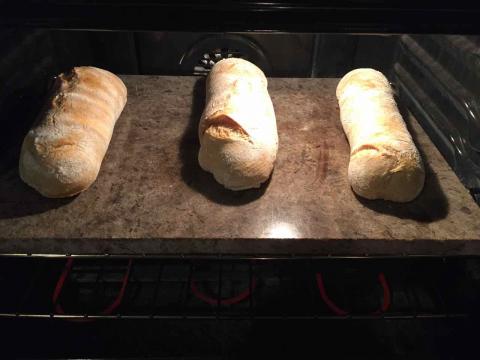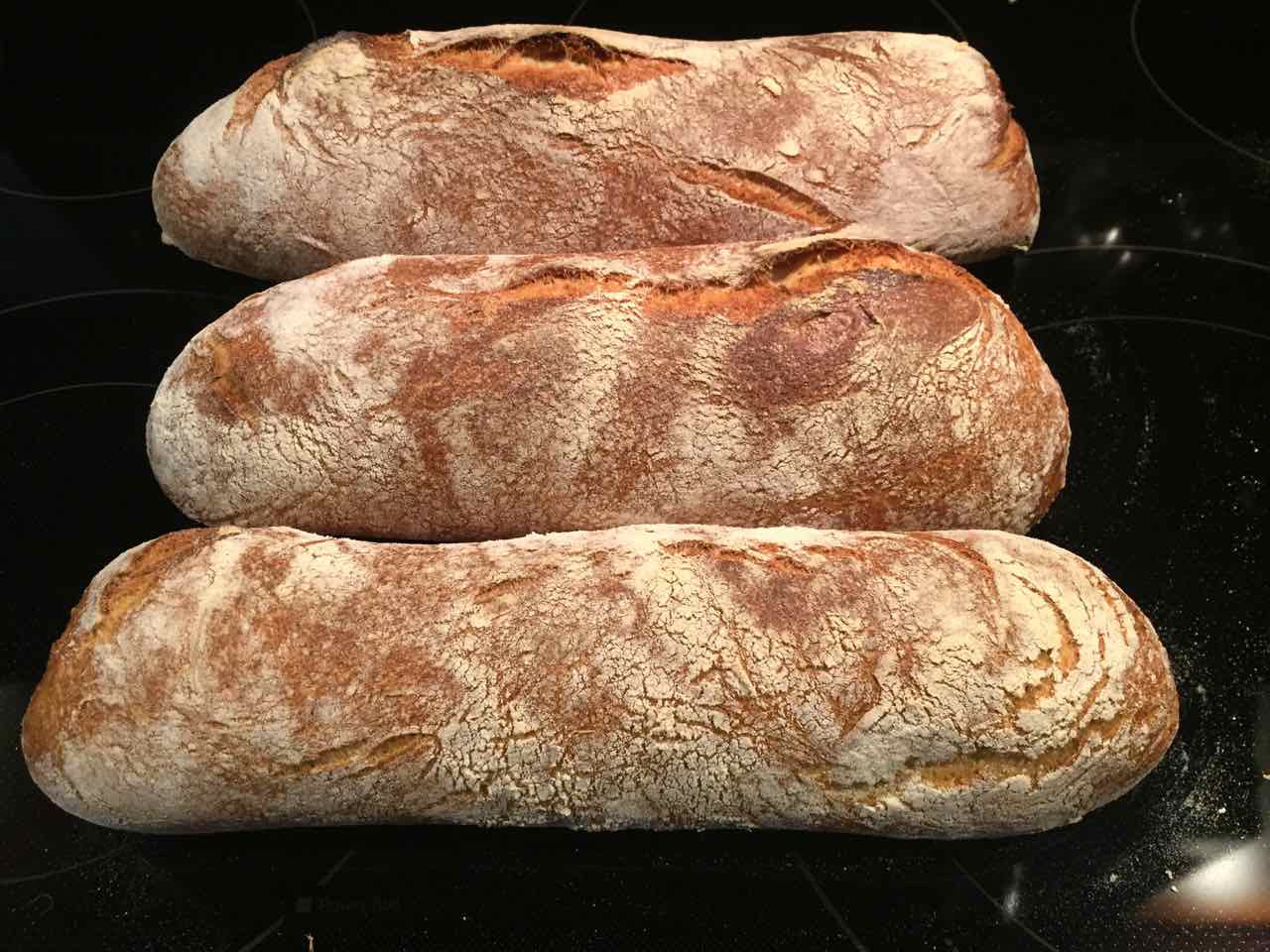
Tritordeum Ciabatta Experiments

Another summer gone, and another summer away from baking. Prior to taking my bake break, I mentioned to my Barcelona friends that upon return, I would also return to complete some unfinished tritordeum business. That being to use the grain in a ciabatta. My recent go-to ciabatta formula is a modified version of Scott MeGee’s biga based dough.
Two runs, two types of tritordeum used. Each was a mix of 50/50 AP/tritordeum, employing the Hamelman-like AP levain at 125% hydration. With bassinage and 3% olive oil, the overall hydration of the total dough stands at 79%. In both cases, the water and the levain are kept refrigerated until mix time, owing to the mixing friction of my old Kitchen Aid planetary mixer raising the temperature as it developed the dough.
As with other ciabatte formula mixes, as the speed of the mechanical mixer increases, I seek two distinct signs that the dough is sufficiently developed. Not only do I listen for the slapping sound of the dough against the sides of the mixing bowl, but I also wait to see the dough being intermittently picked up off the bowl onto the dough hook and then re-deposited onto the bowl. Once these two qualifications are met, the dough has gained sufficient strength, and the mix is over.
The first bake used the 'T150’ flour. The result was a relatively handsome set of loaves although the crumb, while tasty, left a lot to be desired as far as open structure - especially for a ciabatta. I will attribute this to three culprits. 1) Tritordeum is referred to as a low gluten flour in the online literature, 2) the ‘T150’ is akin to whole wheat flour, which will “consume” more of the hydration and also contribute to a tighter crumb, and 3) to my being away from the baking craft for a few months and therefore this served as my refresher bake. I’ll pretty much dismiss the last point as I’ve stepped away before and found little to no degradation in my skill set.
The second bake was with the ‘T65’ tritordeum, and I had just enough of that flour to fashion two 500g loaves before my store of the grain was depleted. On this run, one can see that the crumb is more open and fairly close to when I use 100% KA AP flour at ~11.7% protein. I also decided to allow for a rest time of 20 minutes between the initial incorporation of water and the final mix.
In both cases the shaping was decent, but fell short of being as consistent as I would like. The girth of the loaves also didn't equal what I’ve produced before with all AP flour - the barrel just wasn’t big enough in circumference.
My opinion is that while the ’T150’ version creates a pleasing and tasty bread, it would be hard pressed to pass muster as a ciabatta from the crumb alone and delivered a heavy and dense character to the bread. I would not recommend this as a ciabatta bread. It was quite tasty - just don’t sell it as a ciabatta to avoid disappointment.
The ’T65’ version has more of the ciabatta open crumb characteristic with a crumb that is open enough for what one might expect from a ciabatta at the lower end of the hydration scale. And I think that this version could very easily please most palates and not disappoint when presented as a ciabatta.
This was just furthering my experimentation and knowledge of the grain itself and what it potentially can and cannot do well. And I feel that the 'T65' version holds up quite well to an AP flour with the added benefits and enhanced flavor profile of the tritordeum grain.
In each run all loaves were ~500g.
'T150' Tritordeum



'T65' Tritordeum



And for comparison, here is what the all AP version of this bread looked like from two previous bakes...


Comments
to see another of your Tritordeum experiments and I pointed a lady on IG to your last post on it here on TFL when you came back with bags of the flour from Barcelona.
She also had featured a bake of this flour coming back from a holiday in Spain. Beautiful colour and crumb on those 'slippers'...
No wheatbran on the outside this time and I also have tried this in recent bakes inspired by yourself and was happy with the outcome...but my 'en couche' shaping and proofing are still work in progress to say the least.... Kat
Scott MeGee video a look. I use, as close as I can, his shaping technique for ciabatta. First time that I ever did an actual shaping with this type of dough was after seeing his method. However, I've never seen any ciabatta dough that acts as billowy and holds together as well as his. It is almost like a different product.
At this point I have a scant amount of the'T150' type of the tritordeum left, so if I want more it may necessitate a trip across the pond to find some. But I have so much other flour to play with now anyway. A friend's daughter came back from visiting her parents in Japan very recently, and was kind enough to bring back two kilos of Japanese flour to play with. Of course, there will be payback as she anticipates that I'll be baking some bread with her in mind!
alan
and I shall have a look at the video. I am practicing also more to get an 'extensible' dough to shape semi-baguettes or alternatively a Pan Gallego and use cold bulk and proofing en couche to get those beautiful tapered batards. Pan Gallego with a bun is also a challenge that I have set myself and pondering on the similarities with ciabatta. Many people seem to use a poolish but I try to base it on SD only.... Do you have any tips how to get an 'extensible' dough? I think flour choice might play a part here too and must read up again. Again distracted into too many directions... ha, ha.... Kat p.s. covering bread with wheatbran is a keeper tip...thank you!
and the related links. t might help clarify what you are going after. http://www.thefreshloaf.com/node/54900/functional-effect-biga-vs-poolish
The one line "summary" by Mike Wilson, who specializes in Italian breads is "In summary, a biga for strength, a poolish for extensibility."
Sliced crosswise for the T150 version and lengthwise for the T65 one. The former might not be qualified as "ciabatta", if we actually have a universal standard for that. Yet I doubt anyone would feel disappointed upon receiving a loaf like that. A masterpiece like that. Should such a person exist, please send me his contact and I'd gratefully collect the loaf from him :)
I see that both versions are superior to the all AP one taste wise. Do you find a significant difference between the two though?
Glad to see a post from you Alan!
The mixed flour breads are "tasty" indeed. But I generally gravitate toward the clean taste of a mostly white flour bread, exceptions exist - like a deli rye flavor or a full on semolina bread with sesame seeds. So I can't really quantify whether one is more appealing to me than another between these two and white flour breads. I really didn't find that one tasted more tritordeum-ish than the other. Both seemed to have quite similar flavors.
Thanks for your thoughts, alan
But that last photo is just perfect! Ideal for Bruschetta. How do you like to enjoy ciabatta? Italian breads, with durum flour, really do suit olive oil and tomatoes. Does Tritordeum have the same qualities?
bread is more than 12 hours old. Also a fresh bread heated up in the oven until the crust is, er, crusty again and the crumb is still tender. This is my general rule for mostly all breads.
For me a bruschetta is ideal with nothing more than a garlic clove rub, some olive oil and sea salt sprinkled on top. After that I'll get in line to have a basil, EVOO and tomato bruschetta too.
The flavor of the grain is quite similar to semolina, but I'd have to do a head to head (or bread to bread) comparison as my palate generally can't be so specific to recall unique qualities of foods at differing times when the differences are subtle.